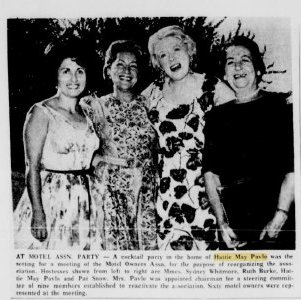From a sprawling mid-century modern home in the luxurious Dessert Inn estate, to a vernacular commercial building, to minimal traditional residences, the following exhibit showcases a sample of Hugh Taylor designs commissioned by women in the Las Vegas Valley between 1955 and 1962. These five women, though of different social and economic standing, are examples of the second wave of feminism of the 1960's.
The lead up to the second wave of progressive thinking was in part due to women's participation in the labor force during World War II, particularly in manufacturing jobs required to support the war effort. This involvement in the work force gave women a sense of liberation from the nuisance of domesticity, allowing them higher paid jobs, social freedom, and a sense of gender equality to that of men. However, as men returned home after the war to reclaim their jobs with higher wages, women were laid off and many refused to retreat to the old ways of domestic life.
By the late 1950's and 1960's, as economic prosperity grew in the US, there was a greater interest to challenge social and cultural norms brought forth with the Civil Rights Movement. The push to confront segregation and inequality in the workplace lead to the conductive atmosphere for a major feminist movement in the 1960's.
Fueled by the writings of Simon de Beauvoir, Betty Friedan, and Katy Millet, the second wave of feminism yielded the establishment of the National Organization for Women, the Women's Liberation Movement, the passing of the Equal Pay Act of 1963, the introduction of the contraceptive pill, and the analysis of patriarchal structure of society. These important events gave women a stand as social economic players by being afforded jobs, social freedom from domesticity, sexual liberation, and the support to stand up to a patriarchal society.
The 1960's witnessed an awakening of the feminine struggle, fueled by discrimination, inequality, and patriarchal oppression that surged the need to fight for economic and social equality. The following five projects give us a glimpse into the lives of independent women during a time of discrimination across the United States.
Showcased women:
Hattie May Pavlo
Ethel Matteuci
Bernadine Van Vlack (L.B. Van Vlack)
Wilma A Jenson
Alice Moore
References:
"What Was the Second Wave Feminist Movement?" DailyHistory.org, 28 Jan. 2019, dailyhistory.org/What_was_the_Second_Wave_Feminist_Movement?.
Santana, Maria C. "From Empowerment to Domesticity: The Case of Rosie the Riveter and the WWII Campaign." Frontiers, Frontiers, 12 Dec. 2016, www.frontiersin.org/articles/10.3389/fsoc.2016.00016/full.
History, Art & Archives, U.S. House of Representatives, Office of the Historian, Women in Congress, 1917-2006. Washington, D.C.: U.S. Government Printing Office, 2007. "Postwar Gender Roles and Women in American Politics," https://history.house.gov/Exhibitions-and-Publications/WIC/Historical-Essays/Changing-Guard/Identity/ (March 25, 2020)
Gordon, Linda. "Socialist Feminism: The Legacy of the 'Second Wave'" New Labor Forum, 3 July 2018, newlaborforum.cuny.edu/2013/09/30/socialist-feminism-the-legacy-of-the-second-wave/.
Visuals
Time Magazine: Feminism
Nevada Preservation Foundation
info@nevadapreservation.org
(855) 968-3973, x. 703
330 W. Washington Avenue, Ste. 106, Las Vegas, NV 89106

